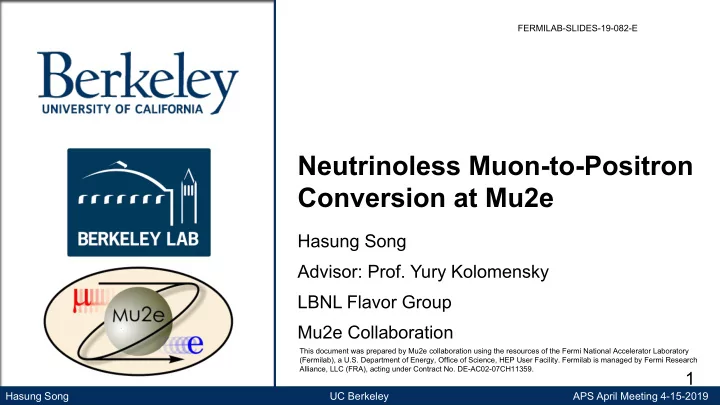

FERMILAB-SLIDES-19-082-E Neutrinoless Muon-to-Positron Conversion at Mu2e Hasung Song Advisor: Prof. Yury Kolomensky LBNL Flavor Group Mu2e Collaboration This document was prepared by Mu2e collaboration using the resources of the Fermi National Accelerator Laboratory (Fermilab), a U.S. Department of Energy, Office of Science, HEP User Facility. Fermilab is managed by Fermi Research Alliance, LLC (FRA), acting under Contract No. DE-AC02-07CH11359. 1 Hasung Song UC Berkeley APS April Meeting 4-15-2019
Outline ▪ Introduction of µ - N→e - N and µ - +(A,Z)→e + +(A,Z-2) ▪ Overview of the Mu2e Experiment ▪ Positron Backgrounds in Mu2e ▪ Background Simulations 2 Hasung Song UC Berkeley APS April Meeting 4-15-2019
Coherent Muon-to-Electron Conversion µ - +Al-27→e - +Al-27 Mu2e’s primary physics goal is the observation of a monoenergetic 105.1 MeV/c electron signal With a single event sensitivity of 3.3 · 10 -17 , any positive signal would be far higher than the SM rate O(10 -55 ) and a sign of new physics CLFV is featured in many BSM theories!! Simulated Mu2e electron spectrum signal & background Current experimental upper bound: SINDRUM II: 7.0 · 10 -13 (90% CL) [1] (Gold) Normalized to ordinary muon captures 3 Hasung Song UC Berkeley APS April Meeting 4-15-2019
Neutrinoless Muon-to-Positron Conversion µ - +(A,Z)→e + +(A,Z-2) A secondary physics goal of the experiment is detecting neutrinoless muon-to-positron conversion A “free” measurement This process not only violates charged lepton flavor conservation but also lepton number conservation Process is analogous to neutrinoless double beta decay Signal is a monoenergetic 92.3 MeV/c positron Current experimental upper bound: SINDRUM II: 1.7 · 10 -12 (90% CL) [3] (Titanium) 4 One of the feynman diagrams contributing to µ - +(A,Z)→e + +(A,Z-2) [2] Hasung Song UC Berkeley APS April Meeting 4-15-2019
Mu2e Overview 5 Hasung Song UC Berkeley APS April Meeting 4-15-2019
Mu2e Straw Tracker/Spectrometer The Mu2e tracker consists of 21,000 5mm diameter straws 18 tracker stations evenly spaced over ~2 meters Designed to be low-mass and provide high momentum resolution ΔP/P ~ .1-.3% Machine learning helps with this Charged particles have helical trajectories that we will fit in 3-D space Simultaneously tracks positively and negatively charged particles ~ 30m 6 Hasung Song UC Berkeley APS April Meeting 4-15-2019
Positron Backgrounds ▪ Radiative Muon Capture (RMC γ ) ▪ Radiative Pion Capture (RPC γ ) ▪ Cosmic Rays 7 Hasung Song UC Berkeley APS April Meeting 4-15-2019
Radiative Muon Capture A muon falls into an Aluminum nucleus in the stopping target and emits a photon This photon goes on to create an electron-positron pair The photon energy spectrum is modeled by the Closure Approximation 𝐹 γ 𝑦 = 𝑙𝑛𝑏𝑦 𝑒𝑂 𝑒𝑦 𝑦 = 1 + 2𝑦 + 2𝑦 2 𝑦(1 − 𝑦) 2 A Feynman diagram of radiative muon capture 8 Hasung Song UC Berkeley APS April Meeting 4-15-2019
Radiative Muon Capture The expected number of RMC positron background events is heavily dependent on the kinematic endpoint, kmax (How high RMC γ reaches) TRIUMF measured RMC kmax at 90.1±1.8 [4] (MeV/c 2 ) but with low statistics Mu2e will independently measure the RMC kmax RMC gamma spectrum measured by TRIUMF with various closure approximation fits [4] 9 Hasung Song UC Berkeley APS April Meeting 4-15-2019
Radiative Pion Capture The vast majority of our pions decay into muons on their way to the stopping target A small number will reach the stopping target and undergo nuclear capture Like RMC, this process can produce a gamma ray with high enough energy to pair produce a signal-like positron RPC Gamma Spectrum of Mg-24 as measured at LBNL [5] 10 Hasung Song UC Berkeley APS April Meeting 4-15-2019
Radiative Pion Capture Pion stops in the stopping target are suppressed by the pion decay time We will further suppress RPC backgrounds by cutting on time Most RPC events occur shortly after proton bunch arrival at production target Timing profile of 1 Mu2e Cycle 11 Hasung Song UC Berkeley APS April Meeting 4-15-2019
Positron Background Simulations Signal Region Signal Region *Preliminary Mu2e Simulation* *Preliminary Mu2e Simulation* 12 Hasung Song UC Berkeley APS April Meeting 4-15-2019
Positron Background Simulations My work involves using GEANT4 simulations of the Mu2e environment to characterize and estimate positron backgrounds Analysis is at an early stage and will continue to be optimized Total Background Estimates: (3 years) Signal Region RMC : 1.2 events *Preliminary Mu2e Simulation* RPC : .004 events Preliminary Sensitivity Estimates: SES = 2.7 · 10 -17 CL90% = 1.0 · 10 -16 Four orders of magnitude better than SINDRUM II SINDRUM II: 1.7 · 10 -12 (90% CL) [3] (Titanium) 13 Hasung Song UC Berkeley APS April Meeting 4-15-2019
Acknowledgements ▪ This material is based upon work supported by the US Department of Energy Office of Science, Office of High Energy Physics under Contract No. DE-SC0018988. 14 Hasung Song UC Berkeley APS April Meeting 4-15-2019
References [1] W. H. Bertl et al., Eur. Phys. J. C47 337 (2006) [2] J. M. Berryman et al., N Phys. Rev. D 95, 115010 (2017) [3] J. Kaulard et al., Phys Rev. B 422, 334 (1998). [4] D.S. Armstrong et al., Phys Rev. C 46, 1094 (1992). [5] J.A. Bistirlich et al., Phys Rev. C 5, 1867 (1972). 15 Hasung Song UC Berkeley APS April Meeting 4-15-2019
BACKUPS 16 Hasung Song UC Berkeley APS April Meeting 4-15-2019
Cosmic Rays In order to reach our sensitivity goals, we must detect 99.99% of all charged particles that fly into our experiment Otherwise, 1 Mu2e signal-like event will happen once a day Expected background contribution is on the order of .25 events over 3 years 17 Hasung Song UC Berkeley APS April Meeting 4-15-2019
Recommend
More recommend